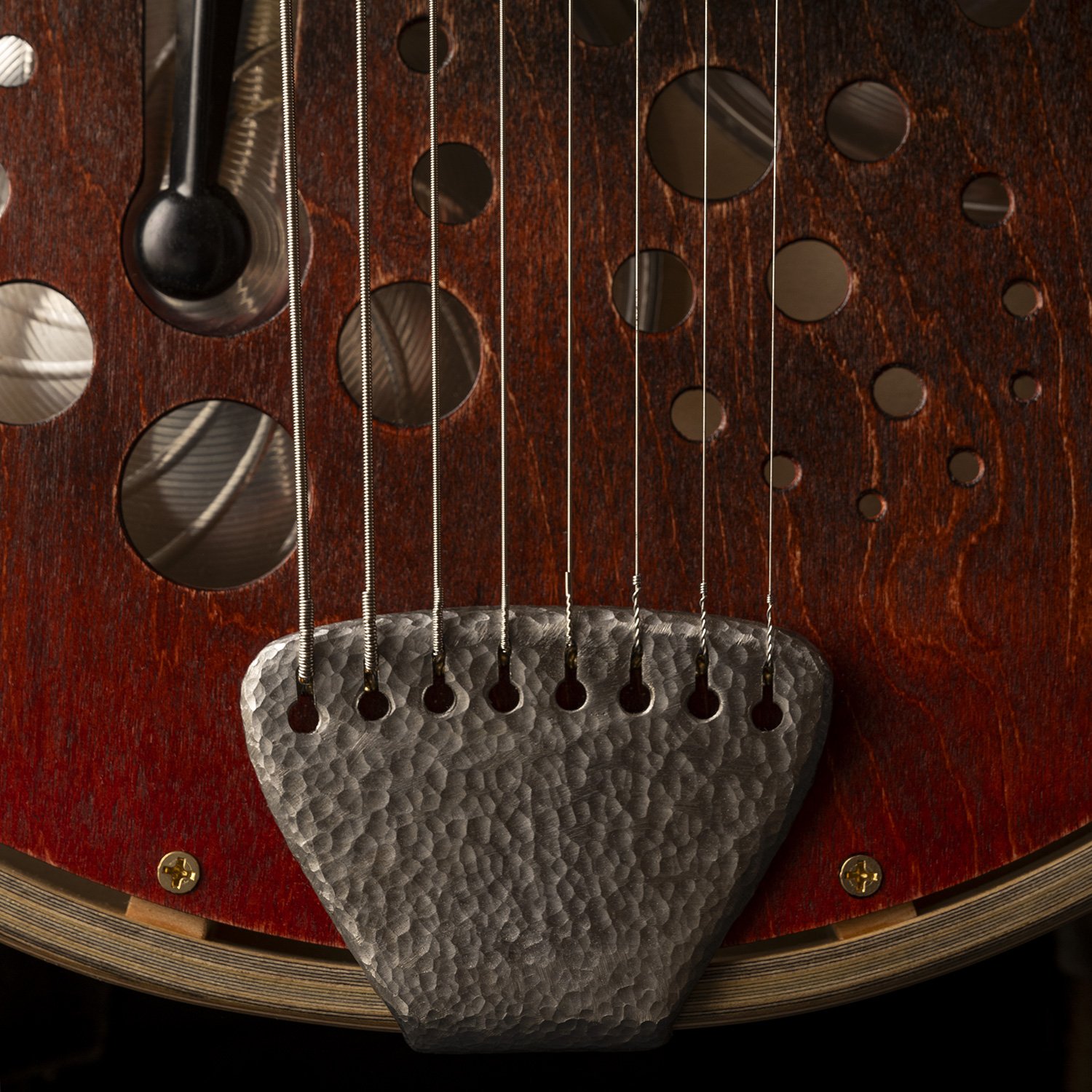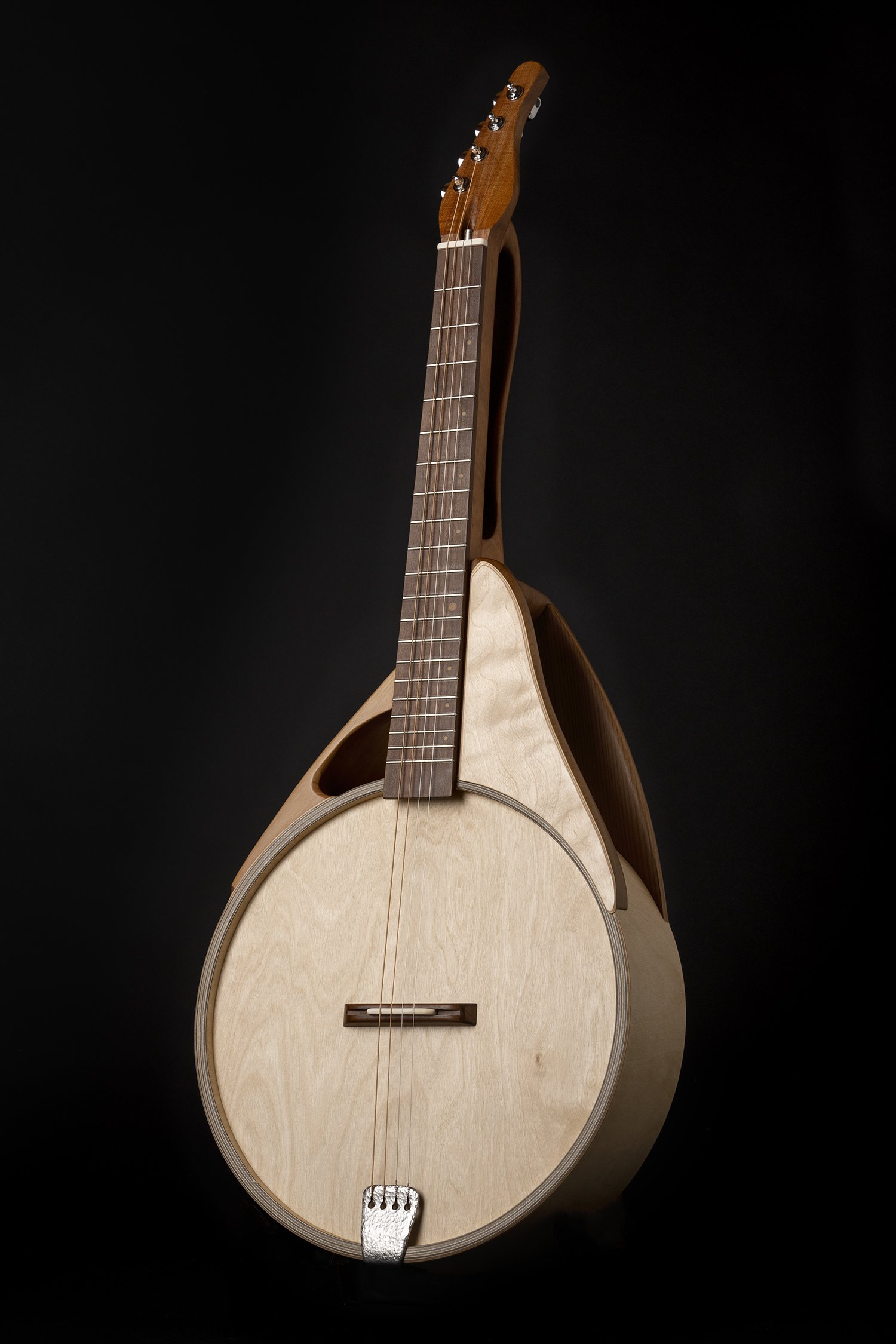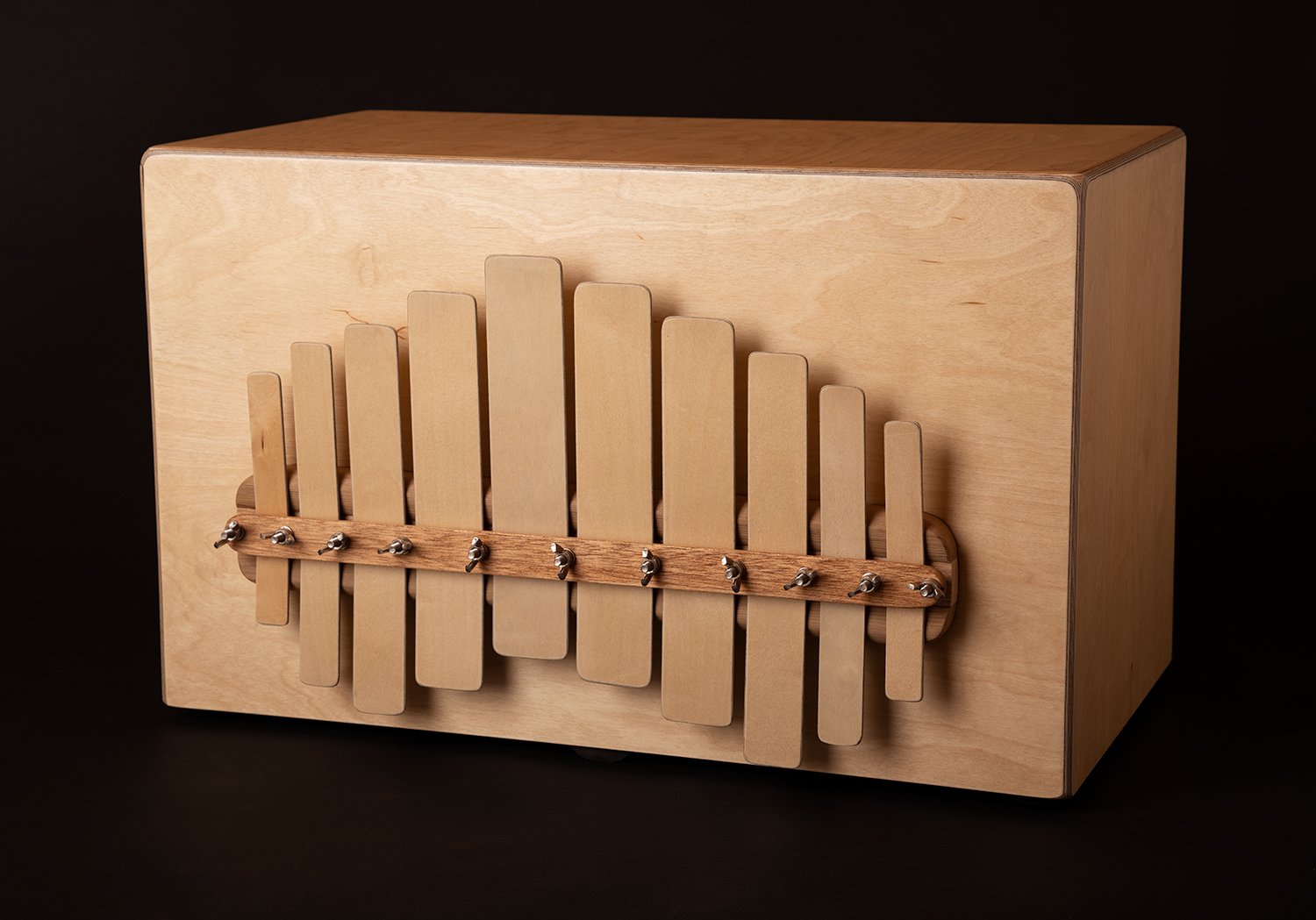Bespoke problem solving
Every component needs to be equally in service to design, function and ergonomics. The objective is to make a beautiful object that is intuitive to handle, a pleasure to use and gives rise to new ideas through it’s particular voice.




“This instrument speaks to me. The unique approach and the bold projection of this 8 string guitar is exactly what I was imagining. That’s no mean feat.”
SDR (Super Dynamic Resophonic) 3.8
Once we had it strung up, it was a case of working through various string gauges until we got the right response and evenness across each of the string ranges. We settled on a custom set from 74 to 13. The tuning at this stage is B E B E G# B E F#, open E with an F#.
This instrument was designed and built for Leigh Ivin and conceived to be a sister to a 1950s twin neck, electric Maton steel guitar with a 597mm (23 & 1/4”) scale length. The Maton was made to take either 6 or 8 strings, and Leigh’s is set up as a 6 string with a wide string spacing.
The brief was to make an 8-string acoustic Tri-cone resonator lap steel guitar that would have a similar feel to play as the Maton. We settled on a 610mm (24”) scale length after doing some testing on one of my mule guitars to get some sense of string tension and to what degree the short scale would compromise bass response. Though not identical, the tri-cone has a similar feel to the Maton. The short scale and heavy strings make the attack very immediate and has no flab about it.
Much of the instrument is made using aircraft-grade Birch plywoods. The chassis is made up of ply hoops, with the ply sides adding to the structure.
The Papua New Guinea Rosewood neck extends through the body to the tailpiece and incorporates a leg rest/handle, availing a wide leg playing position and also a safe and comfortable way to handle the instrument. It has a false back, allowing full movement of the back which is the primary soundboard. The back is very thin and lightly braced with my spoked bracing design.
It has a secondary, circular soundboard on top that is also spoke-braced. Weight distribution is near on 50/50, and twin sound holes are lined with Silky Oak which also doubles as another place to hold the instrument. The tailpiece is handmade from mild steel, the bridge is bone, and the nut is bone on brass. The neck is Yarran with Sycamore veneer for frets and hollow brass pipe for fret markers.
The Promise
“It is wonderful to find a luthier with both the artistic talent and engineering skills to match. A job beyond well done, you have no equal.”
I had an enquiry from Mark in the US asking if I could modified a lap dulcimer. I quizzed him about what he needed and found out that after a medical procedure, he was having trouble with the hand position and pressure required to fret a regular guitar.
After some to-ing and fro-ing, I suggested that if we start from scratch, I could design him an instrument that was more refined and fulfilled his requirements with mush less compromise. I sent him a very comprehensive list of questions. His experience and capacity to articulate exactly what he wanted the instrument to do, dictated every aspect of the design. I asked about his playing style, his body type, setup, possible tunings, how he would be handling the instrument, what tonal range it needed to sit within, dimensions and optimum weight.
This instrument is the amalgam of his requirements and my design language. He wanted a short scale length (22.5 inch/570mm) four-string, small-bodied, fretted lap guitar, setup for DGBE tuning. I settled on a circular soundboard, horn guitar design that would have great mid/treble response and plenty of power.
My designs are based on creating an effective sonic environment within highly considered ergonomics. This instrument is a taut structure that minimises energy loss from the soundboards. I’m running the neck through the body (through the centre of the sound chamber) and it’s tied into a structure that supports the sides. The neck and this additional structure manage the forces of string tension and create rigidity around the edges of the soundboards. The soundboards are more or less free to work as purely resonant surfaces. The back soundboard is recessed into the body, behind a false-back so the leg of the player doesn’t muffle the vibration. With such a significant structure, the string energy has great opportunity to last longer and transmit easier into the soundboards and sound chamber to create harmonic complexity and a long and loud note.
I’ve made a mild steel tailpiece that to add some mass to the tail end.
The complete instrument came in at my target weight of 2.5kg and very close to a 50/50 weight distribution. It’s a pleasure to hold and sits beautifully on the lap. Given the physical size of the body and short scale length, it’s not a bassy tone but sits in the lower mid/mid mids and an emphasis on brightness. It has strong projection and an open, even, rich voice and it’s plenty loud too.
It is finished with hard wax oil which gives a lovely rich matt finish that doesn’t overly stain the timbers just darkens them off. I’m using fairly soft materials in places here and I expect my instruments to age.
Bass Marimbula
This bass marimbula has ten tines (playing keys) and five tuned drums built into the ends and across the back. The tines can be fine-tuned in a number of different keys.
Rear view
I particularly like unusual commissions. I feel the shimmering potential of opportunity. I spend a couple of days in a state of deep problem-solving.
My client showed me a video and asked if I could build a bass marimbula. The video was of an elderly Cuban man playing a traditional 5 or 6-tined marimbula, accompanied by his nephew playing a large pair of thin-skinned bongos. In its traditional form, the bass marimbula is made from found materials and cobbled together. I could see there would be a number of ways to expand the core concept and extend the use of the box structure.
Experimentation began as I delved into material choices and possible uses of the real estate within the box. Rather than having the structure in a thick-walled box, I developed a structural chassis that allowed me to use thinner materials for the sides and bottom. This chassis was partitioned which allowed me to turn the two ends and the back into tuned hand drum-playing faces and I could use the underside as a soundboard. In addition, I did a lot of testing to find the most resonant material, optimum size and thickness for the tines and bridge.
It’s a full-body experience playing this instrument. Its physical size makes it a great resonating chamber for bass frequencies. The soundboard adds sustain and resonance to the tines but also helps to make the drum faces the richest sounding I have made. Having ten tines means that a two-octave pentatonic tuning is possible or any microtonal options you desire.
This bass marimbula far exceeded the initial brief and the expectations of both myself and my client. It’s beautifully functional and has huge projection and melodic complexity that’s belied by its uncluttered appearance.
Dismantlable orchestral gong stand.
This commission was full of specific challenges. The brief was; design and build a beautiful, lightweight, strong, dismantlable gong stand with no single piece over 1 metre.
The stand had to be stable and strong enough to hold a 7kg gong, fit into a road case and be as light as possible for touring. It was also an opportunity to add beauty to the percussion station on stage. It sits well with the aesthetics of the SDR Cajon and Triple Bongos that the client already tours with.
We recognised a secondary use of the stand doubling as a cymbal and bell stand when not being used for the gong.
The design language was in keeping with the art nouveau shapes I gravitate towards in my furniture making, hence the buttressed uprights. The uprights key into the base and the feet lock it all together. No additional parts that could get lost, just a series of interlocking components.










